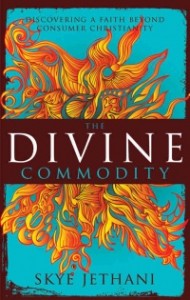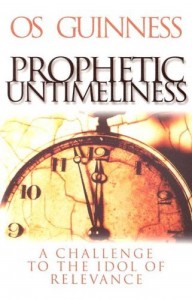The Divine Commodity
 If you’ve ever walked into a Christian bookstore and felt your head spin — or felt suddenly your own aloneness in a church full of earsplitting rock worship music — or cringed to see the advertising spirit at work in the body of Christ — then Skye Jethani’s book The Divine Commodity reminds you that you’re not alone. More significantly, it supplies a well-researched, comprehensive perspective on the ways the “problematic union of consumerism and Christianity” has developed and gained momentum in the evangelical church, how it warps our understanding of our faith, and how we can begin to disentangle our faith in Christ from the web of a commodity-obsessed culture.
If you’ve ever walked into a Christian bookstore and felt your head spin — or felt suddenly your own aloneness in a church full of earsplitting rock worship music — or cringed to see the advertising spirit at work in the body of Christ — then Skye Jethani’s book The Divine Commodity reminds you that you’re not alone. More significantly, it supplies a well-researched, comprehensive perspective on the ways the “problematic union of consumerism and Christianity” has developed and gained momentum in the evangelical church, how it warps our understanding of our faith, and how we can begin to disentangle our faith in Christ from the web of a commodity-obsessed culture.
Pulling together a diverse body of evidence, Jethani, who wears many hats including senior editor of Leadership Journal, weaves together experience, reading, biblical study and cultural phenomena in a very helpful and satisfying way. His approach is three-fold: each chapter explains how consumerism distorts an aspect of Christianity, lays out an alternative, and offers some discussion of the art and biography of Vincent van Gogh as a foil. I was skeptical at first about how such an approach would work; I wasn’t sure at first what van Gogh had to do with anything. But Jethani’s aim is to awaken not just our powers of analysis, but our imaginations, and he does this by structuring his book
the way we encounter a van Gogh painting… One must step away from the canvas for the colors to fuse and the eye to discern the subject. Likewise, the chapters that follow are impressionist in form. They are comprised of short, seemingly incongruent scenes of personal narrative, biblical exposition, and cultural observation. But with distance and reflection they fuse in the mind’s eye to construct a discernible theme.
I was increasingly drawn in as the book progressed, and ultimately this approach worked. I also learned quite a bit about van Gogh that surprised me, such as that he had originally planned to give his life to Christian ministry but was increasingly alienated from the institutional church — the only building, Jethani points out, that has dark windows in the celebrated painting Starry Night.
These pages take us on a journey at once extremely interesting, troubling, and hopeful. The tone is always gracious, noting without condemnation or polemic where popular thinking about church growth or spiritual identity has gone astray. Among the most interesting sections to me were the discussion of the power of brands, the history of the mega-church movement, and in general the wide range of reading and cultural history Jethani brings to bear. At the factual level, I found much that fascinated me, and Jethani’s insightful commentary made for a deeply thought-provoking read. I’ve underlined and dog-eared too many passages to quote, and it has sparked numerous conversations with my husband. At the end of the book are chapter-by-chapter questions for discussion, and I would imagine this to be a fabulous book to read and discuss with other Christians.
Ultimately, Jethani’s solutions — or should I say the solutions God has left us through his Word and centuries of tradition, but which Jethani affirms here — are nothing new. They are the ancient disciplines of the faith: silence, prayer, love and friendship, fasting and hospitality. These, not anything external we may seek in the way of experiences or purchases, are at the heart of the life of faith. And it’s the Holy Spirit, not some master strategy, that’s at the heart of the living church. This refusal to unveil some “new” cure gives the book more weight and credibility, not less.
When I was in my early twenties, I read a book by Erich Fromm called To Have or To Be. It was one of the “big books” of my life: a study of two contrasting modes of existence. Some cultures, Fromm argued, are typically “having” in their orientation. We relate to the world by trying to possess things (and people). Others tend toward more of a “being mode,” able to enjoy things in themselves without desiring to own them. “The difference between being and having is not essentially a difference between East and West,” he wrote. “The difference is rather between a society centered around persons and one centered around things.” I didn’t share Fromm’s worldview or political philosophy, but I found his distinction between being and having very meaningful. It’s always stayed with me, disciplining and informing my perspective.
The Divine Commodity, with its more focused study of the “having” orientation as it’s manifest in the American evangelical church, thus found a welcoming context in my thoughts. I also felt prepared for it, as perhaps many of us do, by certain experiences I’ve had in the church over the years. I was ready for a larger perspective to help me put together all the pieces, and this book filled the bill. At 175 pages it isn’t, as one reviewer noted, totally exhaustive, and maybe there will be future editions that flesh it out still more. But it has the unmistakable flash of real understanding.
One of Jethani’s observations is that we live in a noisy age, filled with words about God — words that are often proclaimed with more certainty and authority than they warrant. But this is a book that needed to be written, one well worth picking out of the avalanche of Christian publications and spending some time with.


